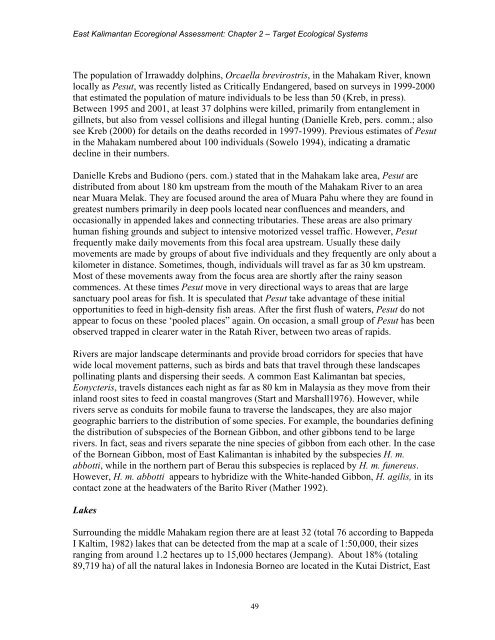Ecoregional Assessment of Biological Diversity in East Kalimantan
Ecoregional Assessment of Biological Diversity in East Kalimantan
Ecoregional Assessment of Biological Diversity in East Kalimantan
You also want an ePaper? Increase the reach of your titles
YUMPU automatically turns print PDFs into web optimized ePapers that Google loves.
<strong>East</strong> <strong>Kalimantan</strong> <strong>Ecoregional</strong> <strong>Assessment</strong>: Chapter 2 – Target Ecological Systems<br />
The population <strong>of</strong> Irrawaddy dolph<strong>in</strong>s, Orcaella brevirostris, <strong>in</strong> the Mahakam River, known<br />
locally as Pesut, was recently listed as Critically Endangered, based on surveys <strong>in</strong> 1999-2000<br />
that estimated the population <strong>of</strong> mature <strong>in</strong>dividuals to be less than 50 (Kreb, <strong>in</strong> press).<br />
Between 1995 and 2001, at least 37 dolph<strong>in</strong>s were killed, primarily from entanglement <strong>in</strong><br />
gillnets, but also from vessel collisions and illegal hunt<strong>in</strong>g (Danielle Kreb, pers. comm.; also<br />
see Kreb (2000) for details on the deaths recorded <strong>in</strong> 1997-1999). Previous estimates <strong>of</strong> Pesut<br />
<strong>in</strong> the Mahakam numbered about 100 <strong>in</strong>dividuals (Sowelo 1994), <strong>in</strong>dicat<strong>in</strong>g a dramatic<br />
decl<strong>in</strong>e <strong>in</strong> their numbers.<br />
Danielle Krebs and Budiono (pers. com.) stated that <strong>in</strong> the Mahakam lake area, Pesut are<br />
distributed from about 180 km upstream from the mouth <strong>of</strong> the Mahakam River to an area<br />
near Muara Melak. They are focused around the area <strong>of</strong> Muara Pahu where they are found <strong>in</strong><br />
greatest numbers primarily <strong>in</strong> deep pools located near confluences and meanders, and<br />
occasionally <strong>in</strong> appended lakes and connect<strong>in</strong>g tributaries. These areas are also primary<br />
human fish<strong>in</strong>g grounds and subject to <strong>in</strong>tensive motorized vessel traffic. However, Pesut<br />
frequently make daily movements from this focal area upstream. Usually these daily<br />
movements are made by groups <strong>of</strong> about five <strong>in</strong>dividuals and they frequently are only about a<br />
kilometer <strong>in</strong> distance. Sometimes, though, <strong>in</strong>dividuals will travel as far as 30 km upstream.<br />
Most <strong>of</strong> these movements away from the focus area are shortly after the ra<strong>in</strong>y season<br />
commences. At these times Pesut move <strong>in</strong> very directional ways to areas that are large<br />
sanctuary pool areas for fish. It is speculated that Pesut take advantage <strong>of</strong> these <strong>in</strong>itial<br />
opportunities to feed <strong>in</strong> high-density fish areas. After the first flush <strong>of</strong> waters, Pesut do not<br />
appear to focus on these ‘pooled places” aga<strong>in</strong>. On occasion, a small group <strong>of</strong> Pesut has been<br />
observed trapped <strong>in</strong> clearer water <strong>in</strong> the Ratah River, between two areas <strong>of</strong> rapids.<br />
Rivers are major landscape determ<strong>in</strong>ants and provide broad corridors for species that have<br />
wide local movement patterns, such as birds and bats that travel through these landscapes<br />
poll<strong>in</strong>at<strong>in</strong>g plants and dispers<strong>in</strong>g their seeds. A common <strong>East</strong> <strong>Kalimantan</strong> bat species,<br />
Eonycteris, travels distances each night as far as 80 km <strong>in</strong> Malaysia as they move from their<br />
<strong>in</strong>land roost sites to feed <strong>in</strong> coastal mangroves (Start and Marshall1976). However, while<br />
rivers serve as conduits for mobile fauna to traverse the landscapes, they are also major<br />
geographic barriers to the distribution <strong>of</strong> some species. For example, the boundaries def<strong>in</strong><strong>in</strong>g<br />
the distribution <strong>of</strong> subspecies <strong>of</strong> the Bornean Gibbon, and other gibbons tend to be large<br />
rivers. In fact, seas and rivers separate the n<strong>in</strong>e species <strong>of</strong> gibbon from each other. In the case<br />
<strong>of</strong> the Bornean Gibbon, most <strong>of</strong> <strong>East</strong> <strong>Kalimantan</strong> is <strong>in</strong>habited by the subspecies H. m.<br />
abbotti, while <strong>in</strong> the northern part <strong>of</strong> Berau this subspecies is replaced by H. m. funereus.<br />
However, H. m. abbotti appears to hybridize with the White-handed Gibbon, H. agilis, <strong>in</strong> its<br />
contact zone at the headwaters <strong>of</strong> the Barito River (Mather 1992).<br />
Lakes<br />
Surround<strong>in</strong>g the middle Mahakam region there are at least 32 (total 76 accord<strong>in</strong>g to Bappeda<br />
I Kaltim, 1982) lakes that can be detected from the map at a scale <strong>of</strong> 1:50,000, their sizes<br />
rang<strong>in</strong>g from around 1.2 hectares up to 15,000 hectares (Jempang). About 18% (total<strong>in</strong>g<br />
89,719 ha) <strong>of</strong> all the natural lakes <strong>in</strong> Indonesia Borneo are located <strong>in</strong> the Kutai District, <strong>East</strong><br />
49

















